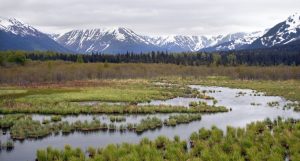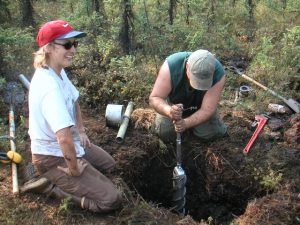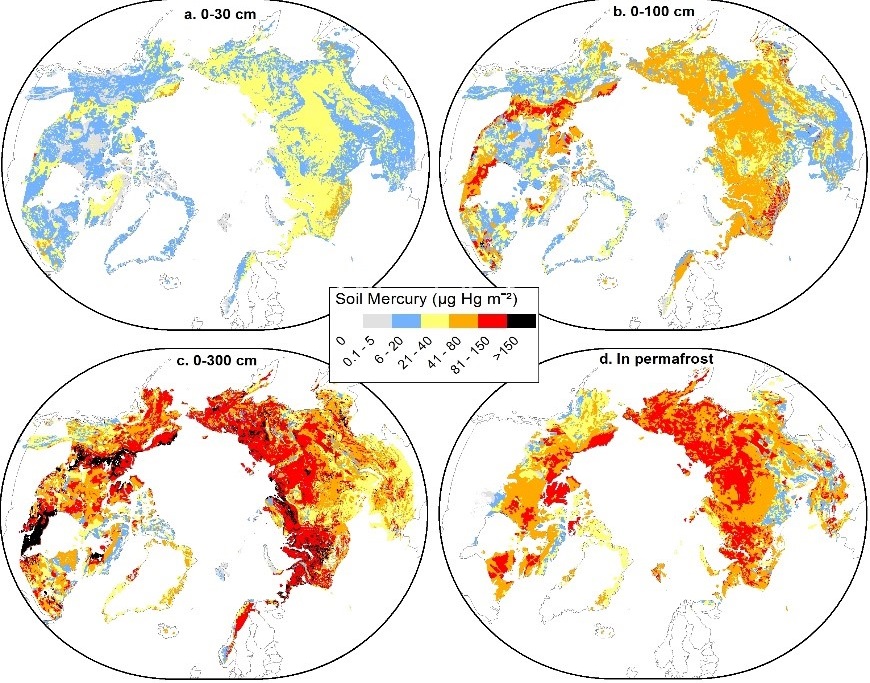5 February 2018

Permafrost in Alaska is thawing, and a new study finds northern permafrost soils are the largest reservoir of mercury on the planet, storing nearly twice as much mercury as all other soils, the ocean, and the atmosphere combined.
Credit: John A. Kelley, USDA Natural Resources Conservation, CC BY 2.0.
WASHINGTON D.C. — Researchers have discovered permafrost in the northern hemisphere stores massive amounts of natural mercury, a finding with significant implications for human health and ecosystems worldwide.
In a new study, scientists measured mercury concentrations in permafrost cores from Alaska and estimated how much mercury has been trapped in permafrost north of the equator since the last Ice Age.
The study reveals northern permafrost soils are the largest reservoir of mercury on the planet, storing nearly twice as much mercury as all other soils, the ocean and the atmosphere combined.
The new study was published today in Geophysical Research Letters, a journal of the American Geophysical Union.
“This discovery is a game-changer,” said Paul Schuster, a hydrologist at the U.S. Geological Survey in Boulder, Colorado and lead author of the new study. “We’ve quantified a pool of mercury that had not been done previously, and the results have profound implications for better understanding the global mercury cycle.”
Warmer air temperatures due to climate change could thaw much of the existing permafrost layer in the northern hemisphere. This thawing permafrost could release a large amount of mercury that could potentially affect ecosystems around the world. Mercury accumulates in aquatic and terrestrial food chains, and has harmful neurological and reproductive effects on animals.
“There would be no environmental problem if everything remained frozen, but we know the Earth is getting warmer,” Schuster said. “Although measurement of the rate of permafrost thaw was not part of this study, the thawing permafrost provides a potential for mercury to be released—that’s just physics.”
The new findings have major implications for understanding how Earth stores mercury and for human and environmental health, according to James Shanley, a research hydrologist at the U.S. Geological Survey in Montpelier, Vermont, who was not involved with the new research.
“This study is very novel and makes a big discovery in an area that was previously somewhat ignored,” Shanley said. “It shows permafrost represents a huge source of mercury, and if it thaws due to climate change the mercury could be released and could significantly add to the global mercury burden.”
Tackling an unknown question
Natural mercury found in the atmosphere binds with organic material in the soil, gets buried by sediment, and becomes frozen into permafrost, where it remains trapped for thousands of years unless liberated by changes such as permafrost thaw.

Study authors Kim Wickland and Paul Schuster drilling a permafrost core at the Bonanza Creek Experimental Forest (BCEF) southwest of Fairbanks, Alaska.
Credit: Bob Eganhouse.
Schuster’s team determined the total amount of mercury locked up in permafrost using field data. Between 2004 and 2012, the study authors drilled 13 permafrost soil cores from various sites in Alaska, and measured the total amounts of mercury and carbon in each core. They selected sites with a diverse array of soil characteristics to best represent permafrost found around the entire northern hemisphere.
Schuster and his colleagues found their measurements were consistent with published data on mercury in non-permafrost and permafrost soils from thousands of other sites worldwide. They then used their observed values to calculate the total amount of mercury stored in permafrost in the northern hemisphere and create a map of mercury concentrations in the region.
The study found approximately 793 gigagrams, or more than 15 million gallons, of mercury is frozen in northern permafrost soil. That is roughly 10 times the amount of all human-caused mercury emissions over the last 30 years, based on emissions estimates from 2016.
The study also found all frozen and unfrozen soil in northern permafrost regions contains a combined 1,656 gigagrams of mercury, making it the largest known reservoir of mercury on the planet. This pool houses nearly twice as much mercury as soils outside of the northern permafrost region, the ocean and the atmosphere combined.
The effects of the released mercury
Scientists are still unsure how much of the stored mercury would affect ecosystems if the permafrost were to thaw. One major question revolves around how much of the mercury would leach out of the soil into surrounding waterways, according to Steve Sebestyen, a research hydrologist at the USDA Forest Service in Grand Rapids, Minnesota, who was not involved with the new research.

Maps of mercury concentrations (micrograms of mercury per square meter) in Northern hemisphere permafrost zones for four soil layers: 0-30 centimeters, 0-100 centimeters, 0-300 centimeters, and permafrost. The permafrost map represents the mercury bound to frozen organic matter below the Active Layer Depth (ALD) and above 300 cm depth.
Credit: Schuster et al./GRL/AGU.
If the mercury is transported across waterways, it could be taken up by microorganisms and transformed into methylmercury, he said. This form of mercury is a dangerous toxin that causes neurological effects in animals ranging from motor impairment to birth defects.
“There’s a significant social and human health aspect to this study,” Sebestyen said. “The consequences of this mercury being released into the environment are potentially huge because mercury has health effects on organisms and can travel up the food chain, adversely affecting native and other communities.”
Edda Mutter, science director for the Yukon River Inter-Tribal Watershed Council, said the new study demonstrates thawing permafrost could have grave consequences for local ecosystems and indigenous communities in the northern hemisphere.
“Rural communities in Alaska and other northern areas have a subsistence lifestyle, making them vulnerable to methylmercury contaminating their food supply,” Mutter said. “Food sources are important to the spiritual and cultural health of the natives, so this study has major health and economic implications for this region of the world.”
The release of mercury could also have far-reaching global consequences, according to Shanley. Mercury released into the atmosphere can travel large distances and could affect communities and ecosystems thousands of miles away from the release site, he said.
Schuster believes his team’s research gives policymakers and scientists new numbers to work with and calibrate their models as they begin to study this new phenomenon in more detail. He intends to release another study modeling the release of mercury from permafrost due to climate change, and said this work changes scientists’ perspective of the global mercury cycle.
“24 percent of all the soil above the equator is permafrost, and it has this huge pool of locked-up mercury,” he said. “What happens if the permafrost thaws? How far will the mercury travel up the food chain? These are big-picture questions that we need to answer.”
###
The American Geophysical Union is dedicated to advancing the Earth and space sciences for the benefit of humanity through its scholarly publications, conferences, and outreach programs. AGU is a not-for-profit, professional, scientific organization representing 60,000 members in 137 countries. Join the conversation on Facebook, Twitter, YouTube, and our other social media channels.
Notes for Journalists
This research article is available for free for 30 days. A PDF copy of the article can be downloaded at the following link: http://onlinelibrary.wiley.com/doi/10.1002/2017GL075571/pdf.
Journalists and PIOs may also order a copy of the final paper by emailing a request to Lauren Lipuma at [email protected]. Please provide your name, the name of your publication, and your phone number.
Neither the paper nor this press release is under embargo.
“Permafrost stores a globally significant amount of mercury”
Authors:
Paul F. Schuster, George R. Aiken*, Ronald C. Antweiler, Nicole Herman-Mercer, David A. Roth, Robert G. Striegl, Kimberly P. Wickland: U.S. Geological Survey, National Research Program, Boulder, Colorado, U.S.A.;
Kevin M. Schaefer: National Snow and Ice Data Center, Cooperative Institute for Research in the Environmental Sciences, University of Colorado at Boulder, Boulder, Colorado, U.S.A.;
John F. DeWild, David P. Krabbenhoft: U.S. Geological Survey, Wisconsin Science Center, Mercury Research Laboratory, Middleton, Wisconsin, U.S.A.;
Joshua D. Gryziec: Environmental Service Lab, City and County of Broomfield, Colorado, U.S.A.;
Alessio Gusmeroli: International Arctic Research Center, University of Alaska Fairbanks, Fairbanks, Alaska, U.S.A.;
Gustaf Hugelius: Department of Physical Geography, Stockholm University, Stockholm, Sweden;
Elchin Jafarov: Los Alamos National Laboratory, Computational Earth Sciences, Los Alamos, New Mexico, U.S.A.;
Lin Liu: Earth System Science Programme, Faculty of Science, The Chinese University of Hong Kong, Hong Kong;
Cuicui Mu, Tingjun Zhang: Key Laboratory of Western China’s Environmental Systems (MOE), College of Earth and Environmental Sciences, Lanzhou University, Lanzhou, China;
Tim Schaefer: Galmont Consulting, Chicago, Illinois, U.S.A.
*deceased.
Contact information for the authors:
Paul F. Schuster: [email protected], +1 (303) 541-3052.
Kevin M. Schaefer: [email protected], +1 (303) 492-8869.
Lauren Lipuma
+1 (202) 777-7396
[email protected]